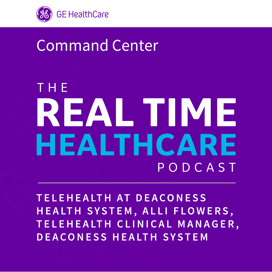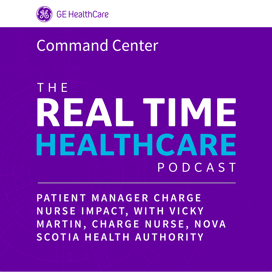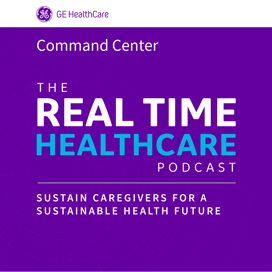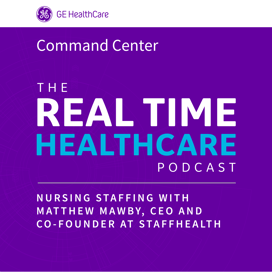In this Episode:
In this podcast episode Jeff Terry, CEO, GE HealthCare Command Center interviews Jen Naylor, Managing Director, GE HealthCare about the Observation Management Tile and how it's used at Tampa General Hospital. The Tile supports the progression of care for observation patients by alerting on outstanding tasks (lab, imaging, consults, etc.) and patient status changes/mismatches
Jeff Terry
Hello and welcome. I'm Jeff Terry. We're here to talk today about the observation management tile and how it's used at Tampa general. Of course, Tampa general is a 1000 bed academic medical center and level one trauma center in Tampa, Florida, innovative in many ways, including they were recently the first hospital in Florida to administer the COVID vaccine. It's our great honor to serve them today. I'm joined by Jennifer Naylor who leads the tiles and command center or care come as they call it program at Tampa general holistically a great program, digital twin process re-engineering surgical schedule, and then a great care comm department and quite a few of our real-time tiles and Jen leads the whole thing. So Jen, thank you for being with us. Hi Jeff. Thank you for having me. So observation management tile, why did Tampa general select that?
Jennifer Naylor
Yeah, so for Tampa has as many as a hundred observation patients in their house at any given time. So it's 10% of their beds. There's about 50 dedicated OBS beds in the house right now. So it's really important for us to have a tool that really manages though, those patients holistically knowing with the strict payer rules, us needing to make a decision, either within two midnights or within 23 hours, whether it rented, admit or discharge the patient really critical for us to look at the diagnostics and understand where they stand with the imaging with labs, with consults, and just make sure that we're progressing their care efficiently. So how do they, how do they use the tool? Yeah, so we have a lot of users of this and this is really outside of the command center, really locally owned by nurses, case management, APPC physicians, and then our physician advisor.
Jennifer Naylor
So I think it makes sense. We can just jump into the tile and I can show you how they use it. Great. So if you click on the observation management tile, there could take us, it'll take us into the tool. One of the first things to call out is that we use this in our daily huddles. So this kind of helps us keep a pulse on the patients within that unit. So you can see right now we have a user that can select their unit. So this one example is the one F one huddle. This will bring up all the patients on that unit. And it's organized in order of length this day. And you can see kind of, they're kind of left to right. We can see the length of stay of the patient. We can see any relevant flags around if they are a to midnight patient, did they have a discharge order?
Jennifer Naylor
We can see the basic patient information we can see from a provider in case management perspective, the status seen that they have put in their orders or notes, and we can also see how when the last time they actually reviewed that patient continuing to the right, you'll be able to see the alerts around what's pending for that patient, whether it's lab consults, imaging, or attending provider required. So you'll be able in the hover to get information on for this patient that we have pulled up is an inpatient consult to cardiology that was placed 16 hours ago. So it's ability to us to kind of check in and it's orange status, meaning that it's alerting us that we're, that we're not necessarily on time. That's something we need to follow up on requests. Meaning if there was an active bed request for that patient, we would be able to see that in that column and then the unit and the bed is just the current location of that patient. So you can see that this is all one F patients
Jeff Terry
It's, it's brilliant. So just a couple of things to ask. So of course, different payers have different requirements in terms of to bid nights versus a straight 24 hour or 48 hour rule. So you're saying the alerting or the, the color coding in those left two columns is based on that per patient. Is that right?
Jennifer Naylor
That's right. So it kind of alarms the care team, whether or not we're approaching the second, mid and night or approaching the 48 hour Mark depending on the payer type.
Jeff Terry
Got it. And then I see also see an OB, a symbol that indicates that a patient has a discharge order on one of those. So we'll see if that's going on. And then I noticed the color coding in these status columns. And I think you mentioned that, so those will turn orange or red. If the status hasn't been updated as frequently as we would like, is that right?
Jennifer Naylor
Absolutely. So we're constantly surveilling Epic in terms of any orders or progress notes. And essentially we're looking for the last time that a provider or case manager has touched that patient reviewed that patient. And we're making sure that they're looking at a specific cadence. And so that's a configurable amount. You can set it for every six hours, four hours, 12 hours. So that's configurable.
Jeff Terry
Perfect. And then the up arrow there, I think indicates that that patient's status has been changed recently, which sometimes would explain why is there an inpatient on, in an OBS unit? Well, because they were upgraded, they, they weren't an inpatient until recently. Okay. That makes a ton of sense. Actually, one last thing I had to call out the color codes they're under alerts. I think you said those are based not on how long that alert has been open, but on the likelihood that it will push the patient over the observation time expectation threshold. Is that right? Yes,
Jennifer Naylor
Really. So as we think about that 48 hour Mark or the two midnight, we're constantly looking at when that order was in relationship to when we need a decision on that patient. So for example, if an lab order was put at 20 hours, but we knew we had to get the patient at 48, we're going to alert according to how close the projected turnaround time plus their current length this day is and alert based on making sure we get within that 48 hours.
Jeff Terry
That's brilliant. Thank you. Please continue. You mentioned some other profiles that that users enjoy.
Jennifer Naylor
Absolutely. So if we go to the next one, it's alert volume. This profile is used by our physician advisor and really the intent of this profile is to look at all the patients with the highest number of alerts, which is an indication potentially that the patient is appropriate for inpatient status. So if a patient has significant amount of imaging procedures, labs, consults, maybe a more complex patient may be more appropriate for inpatient status something. Our physician advisors constantly looking at you'll notice our first patient here listed on the title is an inpatient. The reason they're still on our tile right now is they're currently in an observation unit. So keep going through confirmed discharge order. So we can see everyone with an admission or discharge order on the chart. And essentially we can use that to try to expedite patients through their stay. So you'll see that some of these patients have no alerts and hopefully we can expedite those patients quickly out of beds. And then for those that have an existing alert, looks like we have a couple of lab delays here. Then we can work with the lab to expedite some of those patients to free up those beds.
Jeff Terry
Brilliant.
Jennifer Naylor
And then kind of a good segue to lab delays here. So we can filter the tile to just show the lab delays. And so this is something that is monitored by the lab on a normal basis where we can look at where we've exceeded the thresholds there and they can continue to work those alerts more locally.
Jeff Terry
Okay, perfect. I noticed that and that's sort of descending by observation like the steak. And I should mention for our, our audience, the data you see here is, is fake or de-identified also sometimes the timestamps get wonky. So these six days may be unrealistic, but that's because the data is fake. I would say overall though, it's representative of what we see in practice is that fair to say?
Jennifer Naylor
Yes, absolutely. So the next profile is outpatient procedure. And so what we're looking for with this is really our physician advisors looking at potential procedures and the ones we have coded right now, or mammogram, EGD, and colonoscopy. So really trying to assess whether the patient needs to get done within this day, or this could be better served in an outpatient setting this'll flag. And for review from our physician advisor,
Jeff Terry
We found the one of 107 that, that meets that with a single click. That's great.
Jennifer Naylor
And then the last one is the status mismatch. So going back to what's coded by our providers in case management. And we're really looking at where their status scene is not matching so that we can help facilitate a discussion with the provider in case management to get on the same page and make sure we're aligned on the appropriate level of care for that patient.
Jeff Terry
That's brilliant. Some of those patients are in the to dedicate OBS units, some are in an OBS status elsewhere. And if you click back on the, the first full screen of those patients, just make sure you've mentioned this earlier. But so the mismatch is between the two, the status and the two, you know, by the two types provider, a case management, the color code tells us that the status hasn't been revisited over some configurable about a time in each case. And then the arrow tells us if that has been changed recently, which would explain in many cases why the case management status is out of sync.
Jennifer Naylor
Yeah, absolutely. So sometimes different providers coding, they put in the order for inpatient. And you notice that the case management pill or bubble is colored usually indicates that that case manager hasn't reviewed that patient recently. And they probably don't necessarily see that inpatient order in the chart yet. So it's a kind of a visual cue for that case manager to then revisit that chart.
Jeff Terry
Perfect. One last question on the tile. So I see a snooze and dismiss icon sneaking up. Can you show us that?
Jennifer Naylor
Yeah, absolutely. So if you go to the pencil on the far, right, you'll be able to work very specific alerts or patients. And so if I'm on the lab and I'm currently working a lab delay, and I have a game plan of how I'm going to resolve, I can essentially snooze that as a indication to the care team that I'm currently working that alert. And I can provide a note that will be visible to the entire care team with what my plan is. So once you snooze it, then it kind of grays out. And so essentially just as that signals to the care team, not to really focus on that focus on other efforts, this one's being covered.
Jeff Terry
And I have noticed in practice how useful that is because everybody knows somebody is aware of that and working it and you showed that quickly, but we can snooze a alert. We can also snooze a patient. Absolutely brilliant. Okay, Jen, that's great. Thank you for taking us through that. So a last question, and I'll just close out, close out of the tile here. What's been the feet. You mentioned a lot of users, APS, physician assistants, case managers, nurse managers. What's been the feedback from those great caregivers.
Jennifer Naylor
Yeah. So I think the feedback's been incredibly positive. So I think the essence of it being real time, that, that they can be on their phones on tablets. They can monitor these patients. So as I mentioned, there's half the patients are outside of dedicated OBS units. And so we need to be flexible. So we have a few patients on a specific unit. We can use this tool to kind of see and assess where they're at. So I think in terms of alignment of, of the care team, on what the critical task are in terms of the real time nature and everyone being aware of what's going on and being able to work those alerts together has kind of brought the team together to facilitate stronger flow.
Jeff Terry
That's great. I'm so glad that they find it a useful, wonderful agenda. Thank you so much. Congratulations to you and the team on the work and yeah. Thanks for sharing it with
Jennifer Naylor
Us. Thanks for having me, Jeff.
Jeff Terry
Awesome. And we'll that we will close the podcast.







